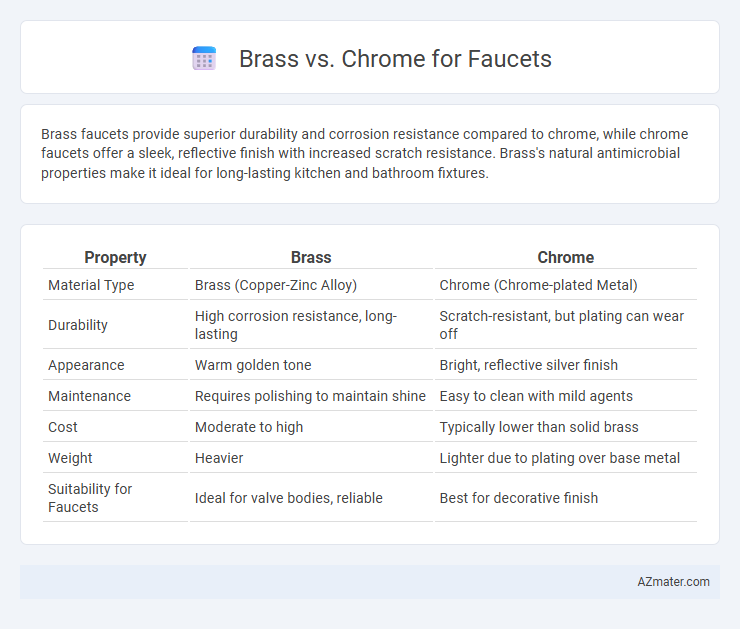Brass faucets provide superior durability and corrosion resistance compared to chrome, while chrome faucets offer a sleek, reflective finish with increased scratch resistance. Brass's natural antimicrobial properties make it ideal for long-lasting kitchen and bathroom fixtures.
Table of Comparison
| Property | Brass | Chrome |
|---|---|---|
| Material Type | Brass (Copper-Zinc Alloy) | Chrome (Chrome-plated Metal) |
| Durability | High corrosion resistance, long-lasting | Scratch-resistant, but plating can wear off |
| Appearance | Warm golden tone | Bright, reflective silver finish |
| Maintenance | Requires polishing to maintain shine | Easy to clean with mild agents |
| Cost | Moderate to high | Typically lower than solid brass |
| Weight | Heavier | Lighter due to plating over base metal |
| Suitability for Faucets | Ideal for valve bodies, reliable | Best for decorative finish |
Introduction to Brass and Chrome Faucets
Brass faucets are made from a durable alloy of copper and zinc, known for their corrosion resistance, longevity, and classic aesthetic appeal. Chrome faucets feature a polished finish that enhances the faucet's durability while offering a sleek, modern look and easy maintenance. Choosing between brass and chrome often depends on preferred style, maintenance ease, and budget considerations.
Key Material Differences: Brass vs Chrome
Brass faucets offer superior durability due to their corrosion-resistant alloy composition, which includes copper and zinc, making them less prone to rust and wear. Chrome, primarily used as a plating material, provides a sleek, shiny finish that enhances aesthetic appeal but relies on an underlying metal, often brass or zinc, for structural strength. While brass ensures long-lasting functionality through its solid construction, chrome plating requires regular maintenance to prevent chipping and tarnishing.
Durability and Longevity Comparison
Brass faucets are renowned for their exceptional durability due to their corrosion resistance and robust metal composition, often lasting 40 years or more with proper maintenance. Chrome faucets, while visually appealing and resistant to tarnish, typically have a shorter lifespan, around 10 to 15 years, as the chrome plating can wear off or chip over time. Choosing brass ensures a longer-lasting faucet with better resistance to wear and tear, making it ideal for high-use environments.
Aesthetic Appeal and Style Options
Brass faucets offer a warm, timeless aesthetic with rich golden tones that complement classic and vintage-inspired interiors, while chrome faucets provide a sleek, reflective finish ideal for modern, minimalist designs. Brass finishes often develop a natural patina over time, adding character and depth, whereas chrome maintains a consistently shiny, polished look that enhances contemporary bathroom or kitchen styles. Both materials come in various styles, but brass leans toward traditional and rustic appeal, and chrome suits streamlined and futuristic decor.
Corrosion and Rust Resistance
Brass faucets offer superior corrosion and rust resistance due to their copper-zinc alloy composition, which naturally inhibits oxidation and extends the lifespan of plumbing fixtures. Chrome plating provides a shiny, protective surface that resists tarnishing and scratching but can wear down over time, exposing the underlying metal to potential rust. Choosing brass ensures enhanced durability in moist environments, reducing maintenance and replacement costs compared to standard chrome finishes.
Maintenance and Cleaning Requirements
Brass faucets require regular polishing to prevent tarnishing and often benefit from mild soap and water cleaning to maintain their warm, natural finish. Chrome faucets are easier to clean, typically needing only a soft cloth and mild detergent to remove fingerprints and water spots, making them more low-maintenance. Brass may develop a patina over time that some homeowners appreciate, while chrome maintains a shiny, reflective surface with minimal upkeep.
Cost Comparison: Brass vs Chrome Faucets
Brass faucets typically cost more upfront due to their durability, corrosion resistance, and premium material quality, often ranging from $100 to $400 for standard models. Chrome faucets, while generally more affordable with prices between $50 and $200, offer a sleek finish but may require more frequent replacement or maintenance over time. Investing in brass faucets can lead to long-term savings despite higher initial costs, as their lifespan and resistance to wear reduce the need for repairs or replacements.
Water Safety and Health Considerations
Brass faucets are valued for their natural antimicrobial properties, reducing bacterial growth and enhancing water safety, while chrome finishes primarily offer aesthetic appeal and corrosion resistance without inherent health benefits. Lead-free, high-quality brass alloys comply with NSF/ANSI 61 standards to ensure safe drinking water by minimizing metal leaching, crucial for preventing lead exposure. Chrome-plated faucets require a brass or stainless steel base to maintain durability and safety, as pure chrome is not used for water contact surfaces.
Best Applications for Brass and Chrome Faucets
Brass faucets excel in durability and corrosion resistance, making them ideal for both residential and commercial kitchens where longevity and reliability are critical. Chrome faucets offer a sleek, modern appearance with easy maintenance, best suited for bathrooms and contemporary interior designs requiring frequent cleaning. Choosing brass benefits high-use environments needing robust materials, while chrome suits aesthetic-focused spaces with lighter use.
Making the Final Choice: Which Faucet Is Right for You?
Brass faucets offer exceptional durability and resistance to corrosion, making them ideal for long-term use and providing a classic aesthetic that enhances kitchen or bathroom appeal. Chrome faucets provide a sleek, modern finish with high reflectivity and easier cleaning, but may be less durable over time compared to brass. Choosing the right faucet depends on prioritizing longevity and traditional style with brass, or opting for a budget-friendly, stylish look with chrome.

Infographic: Brass vs Chrome for Faucet
 azmater.com
azmater.com